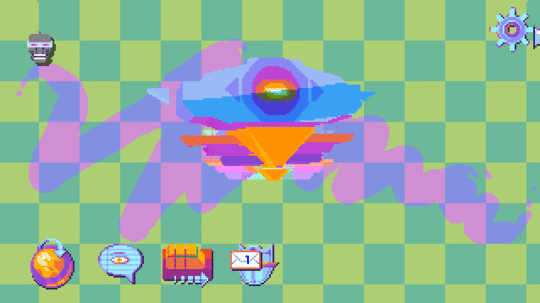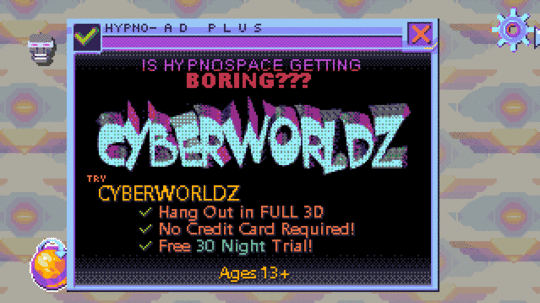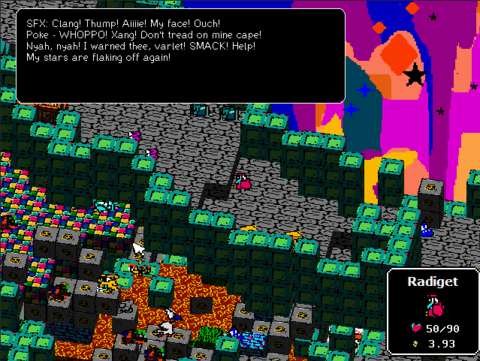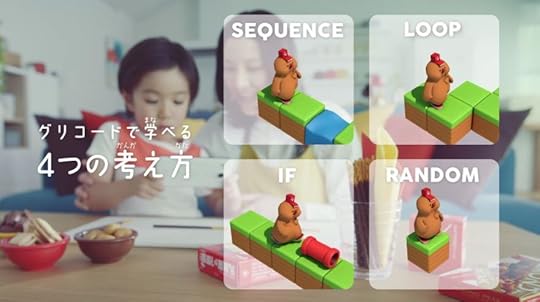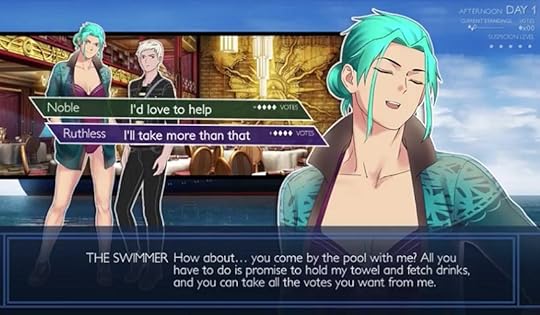Kill Screen Magazine's Blog, page 72
August 18, 2016
Hypnospace Outlaw will turn you into the internet police
Scumbags on the internet causing trouble again? Dropsy (2015) creator Jay Tholen knows who to call—The Hypnospace Enforcers! Hypnospace Outlaw takes players to the literal information superhighway as internet defenders. “In said future, most people work for a powerful corporatocracy all day, and cruise the Hypnospace Highway while sleeping,” Tholen said. “There are competing virtual sleep worlds, but Hypnospace reigns supreme.”
In Hypnospace Outlaw, players are moderators of the Geocities-like future internet. They’re the Hypnospace Enforcers. Much of the design focuses on browsing a series of Hypnospace websites—dancing sprites and flashing text abound—and learning about the folks who inhabit the space. Identifying troublemakers is the main idea; early in the development, Tholen’s identified the Coolpunks as a particular problem. A bunch of “dumb kids” are trying to stage a mass migration to a Hypnospace competitor, and while that’s not technically illegal, talking smack about Hypnospace is.
dancing sprites and flashing text abound
The rules of Hypnospace shift with internet trends—so while talking shit on the provider will likely always be illegal, there’ll be a fine line for when using certain memes, past their prime, will become a chargeable offense. So what do defenders do when they’ve noticed someone breaking the rules? Hop into their digital cruisers and take those suckers down!
Each internet person has a vehicle that represents them on the literal information superhighway. “After you find a violator, you can track them down there and use a Ghostbusters-esque lasso mechanic to apprehend them,” Tholen said. Some vehicles are dangerous, though; players can be infected by adware and viruses on contact. Hackers and rogue AI will serve as “quasi-boss battles,” Tholen added.
There will be a lot to do in Hypnospace Outlaw, but it’s still mostly about the people for Tholen. “It’s similar to what I wanted to say with Dropsy in that it tries to emphasize the unique value of each person in spite of how other people may rank or filter them,” he said.
Hypnospace Outlaw doesn’t have a release date just yet, but it does have its very own website.
The post Hypnospace Outlaw will turn you into the internet police appeared first on Kill Screen.
Every creature in No Man’s Sky is a dog
You drift slowly into the unnamed planet’s atmosphere, eager to set your spacecraft down and explore the endless possibilities put forward by the procedurally generated landscape. The ship begins to shake gently as you make your descent, the view outside reduced to a motion blur of saturated colors as the stars and sky blend seamlessly together. After breaking through the clouds and surveying the area, you pick a safe patch of ground to steer your ship toward. Perhaps this planet is full of water or giant rock formations. Is the fauna abundant here, or nonexistent?
The ship has landed safely—it’s time to leave the cockpit and explore. As you jump down and take in the breathtaking scenery you notice a four-legged creature staring at you. It has a goofy-looking face and the snout of an anteater. There looks to be a fin-like structure on its back, the legs are short and thick, with a few spikes sticking out from its head. This is the most beautiful dog you’ve ever seen.
Procedurally generated planets also mean randomized creatures. Because No Man’s Sky has so many galaxies to explore, it’s unlikely you’ll discover the same creature twice. But what exactly are these animals, then? Some of them look relatively normal, while others look like a Spore (2008) session gone horrifically wrong. I’d like to propose an idea: every single creature you meet in the expansive, diverse galaxies of No Man’s Sky is a dog. Each and every one of them. Does it have tentacles for a face? That’s a dog. Does it have hooves? Is it bright green with a tail twice the size of its body? What you’ve just described there is a dog. In No Man’s Sky, dog is still man’s best friend. And they’re literally everywhere.
Let’s go through the criteria that determine the makeup of a dog:
A. Is a good boy
B. Is not a snake
With that in mind, let’s go into a little more detail. Almost every creature in the game seems to share the common trait of having four legs. That’s a good start, but not all dogs have four legs and so we don’t want to exclude them. But is the dog a good boy? That can easily be determined by interacting with the doggo. If it’s shy and cautious, it’s a good boy. It’s a dog. If it’s hostile and actively trying to kill you, it’s aggressive. Guess what? It’s still a good boy, because it’s protecting itself and you’re proud of it for doing a good job at ripping you to shreds. It’s a dog. Let’s say you come across a dog with two legs. Wow! Truly a marvel, and definitely a good boy. What if it has wings? What if its legs resemble a crustacean? Spoiler alert: it’s a dog. Are pups not allowed to have wings or strange crab legs?
Spoiler alert: it’s a dog
No Man’s Sky emphasizes the feeling of loneliness when exploring the vastness of space or scrounging around for resources. But, luckily, you’re never truly alone because you can just look down and see man’s best friend by your side, all turtle shell and bright yellow scales.
///
Header image by ROUGEZ
Photos of dogs provided by Gareth Damian Martin
The post Every creature in No Man’s Sky is a dog appeared first on Kill Screen.
Disappointed by No Man’s Sky? Here are 10 cheap alternates
Given the mixed reaction to No Man’s Sky—we love it, others not so much—plus the fact that you have to lay down $60 on it in one go (not to mention the troubles with the PC version), perhaps you’re hesitant to buy in. Or, perhaps you’ve played it and have been disappointed by it. That’s fine. But there’s still probably some part of you looking to salve that itch for free-willed space exploration, to lumber across alien landscapes and discover sights that, in all likeliness, no one else will ever see. Well, that itch doesn’t need to go without a scratch.
While No Man’s Sky‘s ambition (and execution) may be somewhat unmatched by a lot of other games, it certainly doesn’t exist in a bubble. There are other studios and individuals who have ventured to create their own procedurally generated universes, eager to let players fly toothless into a void, or to scan planets for alien artifacts locked away by ancient mysteries. And perhaps the best thing? These other games are either free or will only set you back a few dollars. Yep, you can be a space nomad for no more than $9.99 if you so wish.
There’s a collection of 10 games that fit that criteria below. Each of them comes highly recommended and, between them, should manage to satisfy a lot of what No Man’s Sky is all about.
Even the Stars (download)
by Pol Clarissou and Nicholas Gavan
No Man’s Sky has been criticized for its repetitious activities. All the mining and crafting got some people fed up—not that the game asks you to stick with it. If you remove that aspect of the game, you get Even the Stars. Released in 2014, it’s described by its creators as “wandering through space without a purpose.”
You’re given a spaceship, and with it you can enter six-digit warp points in the hopes of finding ancient artifacts and bustling cities. As you have to enter these digits randomly, what you’re going to experience regularly is disappointment—only a star-punched void staring back at you. And when you do find something to explore your interaction is very limited, and so you’ll soon move on. When you run out of fuel, it’s all over, so make sure you spend time to contemplate existence while drifting through the light beams.
Mu Cartographer (purchase)
by Titouan Millet
Mu Cartographer isn’t about space exploration. It’s a game of colorful landscapes, viewed from an alien machine that you gradually learn how to use through experimentation. The pinhole view that you’re given of the planets is your measure. By twirling knobs and pulling elastic triangles around, you learn have to not only move around and zoom, but to shift the contours of the topography.
The game is considered to be a treasure hunt of sorts, as there are items of interest to find, but it’s also a “sandbox toy” that lets you entertain yourself with the lurid, psychedelic mountainscapes and oceans for as long as you like. It’s No Man’s Sky played from a distance.
Noctis IV (download)
by Alessandro Ghignola
Noctis IV may be known to some given that it’s been around since 2000. As with Even the Stars, it’s a space exploration game that doesn’t give you structures to rely upon. To play this you’re going to have a thirst for exploration, especially as the original DOS version of the game has you peering through a 320×200 window into its dense, pixel world.
However, there is a little more to Noctis IV than Even the Stars: it’s much bigger and has within it a lot more variation. There are creatures and forests full of life to be found once you disembark and begin to wander some planets (tip: head for Class 00 stars). But, a lot of the time, you will probably be alone, surrounded only by striking horizons, space dust, and strange motionless architecture that bears down upon you. You do get to name the things you find, though, just like in No Man’s Sky. That should help with morale.
(Bonus: There’s a mod of Noctis IV that makes it a little easier to play, and gives you a bigger view.)
Norman’s Sky (download)
by Ivan Notaros
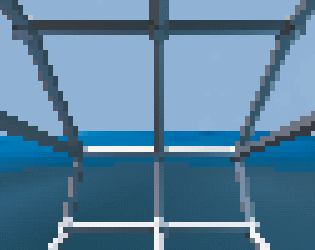
Yes, the title is a purposeful riff on No Man’s Sky. And the game itself is very much the same. Made for the LowResJam earlier this year, Norman’s Sky is a distillation of one of No Man’s Sky‘s biggest promises: the ability to fly to and land on any planet you see in its virtual universe. You can’t do much when you do land given that you’re tied to a cockpit view, i.e. inside a spaceship, for the entire game, but that’s besides the point. Norman’s Sky is a wish fulfillment. You want to zoom around space, hopping from planet to planet, right? Well, here you go.
MirrorMoon EP (purchase)
by Santa Ragione
MirrorMoon EP is a game led by shape, color, movement, and the synthesis between each. It’s a space adventure unlike most others. It starts you off on a red planet that you can walk the circumference of in a matter of seconds. While it is a game of some scale, it is less concerned with attaining magnitude through enormous space and more through its otherworldly mysteries.
The less said about it the better, as it’s an experience meant to be figured out; wordless, without instruction, allowing you to explore the cosmic functions of a handheld tool through intuition alone. Part of No Man’s Sky is learning to understand alien tongues—MirrorMoon EP parallels this, except its language comes not from a creature’s mouth, but the magical art of science.
Space Engine (download)
by Vladimir Romanyuk
An ongoing work, Space Engine is, perhaps, even more daring than No Man’s Sky. It, too, has procedurally generated galaxies with a vast number (the creator goes so far as saying “trillions”) of globes and stars. It, too, lets you land on distant planets and moons, as well as asteroids, from where you can watch landscapes cycle. And soon, it, too, will let players bring in their own textures and models for the engine to generate.
But it also contains an accurate simulator of our own solar system as well as the rest of the known universe, it all based on astronomical data, letting you fly out from Earth and out to the wilder reaches of space. It also doesn’t force upon you any of the survival game attributes that No Man’s Sky has, letting you freely explore, to admire light patterns and the continental swirls of planets, all without needing to refuel.
Verreciel (purchase)
by Devine Lu Linvega
Played on a phone or tablet, Verreciel is an enigmatic space exploration game that takes place inside a Glass Ship. Initially, you’ll need to get used to how to work the Ship, connecting nodes and functions of the consoles that surround you. Once you get the knack for it, you’ll be able to move around its star systems, harvesting currencies and collecting warp keys to get to new locations.
Compared with other games in this list, it might be a bit too fiddly for some, its intricacies not quite friendly enough on first pass. But those who take the time to get acquainted will be rewarded with the subdued beauty of its geometric appropriation of space and its celestial bodies. The advantage of a Glass Ship is that you can see all around.
Elite (play)
by Acornsoft
Before No Man’s Sky there was Elite. It’s the 1980s answer to No Man’s Sky. Imagine No Man’s Sky but made out of vector art. Elite was originally released back in 1985 for the BBC Micro and has since been ported to a bunch of other systems of around that time. Many would call it a classic, its vast universe being unprecedented at the time, and going on to influence open-world design in some of the biggest videogames ever made. No Man’s Sky is, of course, one of those.
The idea in Elite is to make a living by accumulating credits. You can do this a number of ways: piracy, trading, bounty hunting, mining asteroids, and completing missions for the military. With the currency, you can upgrade your ship so that it can travel to new galaxies, of which there are eight in total, with 256 procedurally generated planets to find across them. These numbers may be small in comparison to No Man’s Sky, but it can be considered the seed from which that game has grown from.
FTL: Faster Than Light (purchase)
by Subset Games
If it’s space combat you’re after then FTL: Faster Than Light has you covered. While you do get to explore its vision of space, it is limited, especially as you’re being chased by a huge rebel armada that wants you dead. You travel across sections of space in turns, choosing between different set paths in the hopes that the game’s random generation will give you a lucky break—perhaps a new technology, another crew member, anything to help you survive.
But it could just as likely be an enemy ship who you’ll then have to confront in heated battle. You can play in real-time or pause to better consider your moves. Either way, you’ll have to wait for reload times, to instruct your crew to put out fires, and move them around different rooms to attend to different functions of the ship. You will perish, many times, but FTL makes it easy to get right back in for another round of exchanging laser fire.
Out There (purchase)
by Mi-Clos Studio
Similar to FTL, Out There focuses on survival during space travel, but it differs in that it isn’t concerned with combat. Instead, you’ll be whipping around a view of space that belongs to a 1960s sci-fi graphic novel, stopping off at planets and anomalies to mine for resources and find lost technology. Whereas FTL has you dealing with interspecies relations, Out There is more akin to No Man’s Sky in that it is about loneliness and carries with it an existential tone in its sharp writing.
The advantage of playing it over No Man’s Sky, too, is that it distills what is a similar experience, at least tonally, into something you can play in minutes rather than hours. The reason being that you’ll die that frequently, running out of fuel or oxygen, or coming across an unexpectedly nasty part of space that rips you to shreds. There’s plenty to find in Out There but it also gives you enough time for contemplation too.
The post Disappointed by No Man’s Sky? Here are 10 cheap alternates appeared first on Kill Screen.
You can Play Deus Ex GO while you wait for Mankind Divided
Even though the board is bared to both players, chess is a kind of stealth game. Each piece is moved in plain sight, but a successful chess player is hiding her intentions from her opponent. That opponent understands that her goal is to force a checkmate, but spends the game trying to deduce and block the path she plans to take to accomplish that. Similarly, games like those in the Deus Ex series open up multiple paths forward to the player and introduces obstacles along them to encourage her to think about the state of the playspace now, 30 seconds from now, or two minutes from now.
The newly released Deus Ex GO is the most recent entry in Square Enix’s chain of mobile-aimed abstractions of their larger games. It occupies a space somewhere between the slow ponderousness of a game like chess and the cinematic takedown-filled action of Deus Ex: Human Revolution (2011). Deus Ex GO is less abstracted than the skeumorphic Hitman GO (2014) or the cel-shading of Lara Croft GO (2015). The elaborate takedown animations, the portrait-based dialogue scenes, and the relatively un-stylized graphics come together to make Deus Ex GO feel less like an abstract spin-off and more like a game that aspires to be bigger than it is.
a game about lines of sight and blocked points
The puzzles of Deus Ex GO are based on a triangle-tiled patterns that loosely connects it to the logos and intro cinematics of the Deus Ex reboot. The result is that, from any one point, there are six available directions rather than four, meaning that Deus Ex GO is largely a game about lines of sight and blocked points. It introduces guards that chase you on one path and turrets that fire in a straight line before giving you the ability to hack turrets to be friendly or rotate certain tiles.
Most levels start you off in a loop. You go around in circles and can’t quite put the right number of spaces between you and an enemy to take them out until you’ve changed the terrain somehow. A lot of tile-based puzzlers—games like 868-HACK (2014)—rely on this format, where the key is in rearranging the units on the board so that one piece can move out of alignment with the others. Each new obstacle or hackable tile makes sense—one robot will attack you like a guard, but can’t chase. Another robot patrols in lines. The slow introduction of reasonable obstacles makes the puzzles more interesting, even if only a handful of them are genuinely hard.
Deux Ex GO also offers “Events” every week, in the form of a new puzzle for every weekday. If you complete all five, you can earn some kind of tie-in points for the upcoming Deus Ex: Mankind Divided. With all the elements in play, these are some of the most tightly-designed and complex puzzles the game has to offer, although they still go by pretty quickly.
You can purchase Deus Ex GO for $4.99 on the App Store for iOS and Google Play for Android.
The post You can Play Deus Ex GO while you wait for Mankind Divided appeared first on Kill Screen.
Magic Wand captures what it’s like to play RPGs as a kid
Sign up to receive each week’s Playlist e-mail here!
Also check out our full, interactive Playlist section.
Magic Wand (Windows, Mac, Linux)
By thecatamites
Stephen Murphy, aka thecatamites, is perhaps best known for his parody game Space Funeral (2010). In it, he deconstructs the JRPG by taking the nonsense logic of their fetch quests and oddly single-purpose characters to new extremes. He proves it doesn’t take much for the JRPG to go from a fiction we can accept to an absurd cadaver of meaning. You can tell Murphy has fostered a love for JRPGs, but it’s a love for their encapsulated stupidity, their self-enclosed mania, and it’s this he plays around with. He does this again with his latest game, Magic Wand. It bears all the icons of a Japanese-style RPG; “there are doors and trees” as Murphy points out, but its plot cannot be grasped, and so you move on listlessly from one area to the next, conversing and swishing your sword. A sentient knife says “Cut. Cut.” There’s an entire culture dedicated to digging up pots. It’s as if every character has based their purpose around their immediate form or surroundings, creating a tapestry of unified nonsense.
Once, Murphy wrote about playing mainstream games as a kid, never able to understand them, but assuming they were made for a “phantasm audience” who presumably had better taste and knowledge than him. “[P]eople who make these things have Real Jobs and a logo and live in LA, so they must know what they’re doing,” was his thinking. He grew up to learn that this was bullshit; that, actually, they were just bad videogames. With Magic Wand (and his other games), Murphy gives us a chance to experience what he did as a kid, when he played games on the assumption that they had a purpose and meaning beyond his comprehension. You keep on playing, as Murphy suggests, not for the plot, but for the “music and colours.”
Perfect for: Friendly ghosts, JRPG fans, assorted NPCs
Playtime: An hour
More about Magic Wand can be conjured here.
The post Magic Wand captures what it’s like to play RPGs as a kid appeared first on Kill Screen.
The Long Dark and the legacy of Canadian literature
Your plane has crashed in the wilderness of the Canadian North West. The houses are empty, the cars won’t start, the radios are silent. If you seek shelter or answers in the nearby Hydro dam you are greeted by neither. Instead, a rabid wolf is likely to tear you in half. This is The Long Dark, a Canadian survival game where you play as bush pilot Will Mackenzie. In this otherwise realistic game, wolves—who normally avoid humans—have become Will’s top concern. The mysterious geomagnetic disaster that the game depicts has disturbed the minds of all the wolves. Okay, but that doesn’t explain why one wolf, dubbed “Fluffy” by the game’s community, has decided to live in the Hydro Plant. Yet, Fluffy’s choice of home isn’t a mistake, it’s genius, and it’s worth going through the game’s Canadian cultural influences to explain why.
Although the game is still in development, it’s obvious from your first moments in The Long Dark that it’s inspired by some Canadian cultural giants. The art style is reminiscent of the Group of Seven—famous painters who relied on simple shapes full of movement, impressionistic technique, and (usually) bright pallets. In the game, the skyline is always changing with simple mountain silhouettes appearing at sunset first in blues, then in reds, and then purples before collapsing into black. The whole rainbow is utilized for different times of the day. But if you happen to be near the farmhouse, in Pleasant Valley, when the sunrise has cast a soft yellow, you can’t help but be reminded of the 1933 painting “Winter Charlevoix County” by the Group of Seven member A. Y. Jackson. Similar comparisons can be drawn anywhere in the game’s vast and yet quintessentially Canadian locations, from the ice fishing huts to campgrounds.
There are connections beyond the art style, too. The very idea of a “survival” game will ring familiar for Canadian literary theorists. The original guide to Canadian literature was published by Margaret Atwood in 1972, and she called it “Survival.” Her thesis was that Canadian culture and thus the Canadian literary landscape were characterized by the struggle to live in land that was once unknown and hardly habitable. She identified two kinds of survival, the first is “grim” survival in the face of disasters. The second is “bare” survival on a rugged and hostile land that is largely empty (the Aboriginal people were imagined away, or seen only as Victims/Victors at the time of Atwood’s original analysis). Atwood noted that bare survival was the dominant theme. Literature often depicted a struggle against the horrors of nature, heightened by the intense beauty of the deadly land.
Both types of survival are found in The Long Dark. If you play as Will Mackenzie you will face potential death by cold, starvation, thirst, infections, and even parasites. If you explore for too long you’ll become exhausted and frozen, but if you wait out a blizzard inside you run the risk of cabin fever. All around you are the signs of a terrible disaster. Corpses are everywhere and none of the technology is functioning. Yet, the game is full of sublime beauty. In literary terms, the sublime is achieved when horror and beauty collide. It was characteristic of the poetry of the Romantics, who found this turbulent power in nature and were both awed and humbled by it. In The Long Dark the sublime is found often in simple things. Sometimes it’s in the primal comfort of a few quiet minutes spent cooking deer meat and a pot of coffee on a fire. Sometimes it’s in reaching the top of Timber Wolf Mountain and looking to the trees below. The Long Dark has been praised many times for creating such moments of visual or emotional splendor.
the sublime is achieved when horror and beauty collide
In many ways, The Long Dark calls back to the Romantics’ conception of a nature that was restorative to the human mind but also in conflict with human creation and society. In the minds of many of these 18th century poets, nature would eventually overcome the industrial destruction humans created. It is thus significant that so many facets of industrial human society are depicted as inoperable in The Long Dark. A railway track runs through one area, its crashed train offering little supplies and no shelter to Will Mackenzie. To the north of the track is a logging camp that is clearly practising the clear-cut method that is destructive to the ecosystem. A coal mine connects various locations. If you want to use that coal you can go to the stuck ship “The Riken” off the frozen coast. The signs of human destruction of the wilderness are everywhere, such that you’ll find yourself navigating by their landmarks.
It is clear that The Long Dark is not the empty wilderness that many novelist’s featured in Atwood’s “Survival” depicted. Settlers have long been in the Canada featured in The Long Dark, and though you’ll find their corpses everywhere, they have left their environmental destruction behind. If you go fishing, you’ll find the Smallmouth Bass only in the least populated areas, and the game will alert you that the species is intolerant of polluted waters. Tree saplings are valuable for making bows and arrows, but you can hardly find them anywhere, as is characteristic of unhealthy forests. Then, in front of a processing plant, you’ll come across the huge bones of long dead whales.
Hence, when Will Mackenzie finds Fluffy, rabid and vicious in the Hydro Dam, the encounter serves to cement the connection The Long Dark draws between survival and human society. Without our technology the modern human is highly unprepared for the survival experience. Instead, it is both nature and shoddy modern materialism that Will has to compete with. Our homes are not the safe haven they once were. The wilderness has forced its way inside. What the fleeing residents left behind won’t help Will much either as plenty of the items he finds are trash. There’s low quality food that will make him sick, cheap cardboard matches that aren’t likely to make a fire, jeans that are (as the game quietly informs you) completely useless in the wilderness. Why did no one in this cold British Columbian town own a Mariner’s Coat? It’s the best clothing for wind blocking, it’s head and shoulders above other coats for warmth, and I’ve found it twice in my 100 hours of play. Instead, the items Will can craft from nature are much better for survival. A bearskin bedroll is the warmest sleep you can find, healing poultices can be made from tree lichen, arrows are craftable and retrievable (unlike bullets), and just one deer can bring you days of happy eating while a house might contain little risk-free food.
While bringing the classic Canadian survival theme to videogames The Long Dark also brings a new dimension to the theme itself. The Long Dark is not an empty wilderness in which we struggle to survive, but one full of human intervention, creation, and destruction for both better and worse. The game brings harsh light to the cluttered campgrounds, found everywhere in the game, where Canadians seek to recapture that sense of survival in an environment where there’s little true risk and a facade of preparedness that falls flat. This game questions our ability to survive in a landscape which we are actively destroying and presents the horror scenario where our technology goes dark and we have to face the destruction and unpreparedness we have brought upon ourselves.
The post The Long Dark and the legacy of Canadian literature appeared first on Kill Screen.
August 17, 2016
Mother Russia Bleeds will pound your fists red on September 5th
Devolver Digital’s new(ish) publish is crowned by the hammer and sickle, the symbol made famous by the Soviet Union, but in place of the hammer is a golden syringe. A look at the game itself sees dark corridors, growling dogs, ripped bouncers, and lots of bodies. Mother Russia Bleeds, or rather, MOTHER RUSSIA BLEEDS, is a beat-’em-up in the most earnest interpretation of the term. The latest news is that it’s due out September 5th for PC and coming to PlayStation 4 at a later date.
It’s supercharged to Hotline Miami (2012) levels of violence, and set against the backdrop of the former U.S.S.R. We’ve come a long way from Streets of Rage (1991): Mother Russia Bleeds is all about bloody glory, and this time, we’ve got enough pixels to see it.
There’s a plot somewhere in the game
It’s been in development by French studio Le Cartel since 2014, and I presume all that time was spent working on the viscera and squelch noises, as well as on the decision of what ubiquitously Russian names to use (they ended up deciding on Sergei, Ivan, Natasha and Boris, crowdsourced from their fans).
There’s a plot somewhere in the game, obviously, something about drug addicts and jail and vengeance, but more importantly you can kill stuff for hours and hours and hours. There are bonus difficulties—survival and boss rush—plus local co-op for up to four people, so you can kill stuff with friends, too. You’re also able to go into berserk mode from drugs that you extract from the corpses of people you kill, which is a surprisingly BioShock (2007) twist to a genre that was made popular by Final Fight (1989). Probably something to do with that plot thing. Back to killing.
Mother Russia Bleeds‘s goal, amid all the carnage, is to freshen up the beat-em’-up. As a genre it has languished, occasionally explored by something like Guacamelee! (2013) but much more often abandoned in favor of the hack-n’-slash or the shooter. Le Cartel wants to change that. And if the action holds up as much as the gore, it just might work.
Mother Russia Bleeds is out September 5th for PC. It’s coming to PS4 later this year. You can find out more on its website.
The post Mother Russia Bleeds will pound your fists red on September 5th appeared first on Kill Screen.
Try to outdo Olympian athletes from the comfort of your armchair
With the majority of the 2016 Rio Olympics now behind us, it’s easy to feel a little inadequate. Michael Phelps has now won more Olympic gold medals than anyone in 2,000 years; Simone Manuel made history on Thursday when she became the first African-American woman to win an Olympic gold medal in swimming; and 19-year-old Simone Biles won three-for-three gold medals in the first week and won her fourth on Tuesday, making her the first U.S. gymnast to ever win four Olympic gold medals.
As Olympians prove their supreme athletic prowess, you prove just how many hours you can sit still in front of a screen, cheering them on from your seat. They tear across the finish line; you tear open a second bag of Cheetos. They bite down on their medals in triumph; you bite down on your Cheetos. In your heart, you know you could wow the crowds like Phelps, Manuel, Biles, and their fellow athletes. You just weren’t given the chance!
the real deal takes 200 to 300 shots a day practicing
Finally, what you’ve been waiting for through all the disheartening medal ceremonies is here: Armchair Olympian, by Stuart A. Thompson and Max Cohen with illustrations by Jessica Kuronen, gives you the opportunity to prove that you could stand toe-to-toe with these world-class athletes without ever leaving your computer. Made up of five different minigames, Armchair Olympian tests everyday skills, such as timing, rhythm, precision, and memorization, that Olympians must master before they can dominate their sport. Experience the excitement and competitive spirit of Rio from home with this simple, colorful browser game that asks you: “Can you become an Armchair Olympian?”
Pick between the five minigames that explore the mechanics of several Olympic sports to learn what is at the core of each one. Sprinting tests reaction time, reminding the player that the athletes in Rio have racked up hundreds of hours training and conditioning themselves for this race, “and their reaction times, after thousands of repetitions, are swift.” Rowing and synchronized swimming test timing, rhythm, and muscle memory, honing your ability to move as one with your teammates. Long jump tests timing and anticipation, and archery tests precision and accuracy.
Of course, at the end of the day, Armchair Olympian is there to remind its players, in an asterisked aside, that “this isn’t real life.” Even if you score better than some Olympic archers (as I did, hitting the bullseye 40 percent of the time), you’re playing an internet minigame while the real deal takes 200 to 300 shots a day practicing for the Games. “Don’t get too excited,” the game advises cheekily.
Find out whether you have what it takes to become an Armchair Olympian here.
The post Try to outdo Olympian athletes from the comfort of your armchair appeared first on Kill Screen.
Now kids can learn how to code with Japanese snacks
First created in 1966, Japanese candy maker Ezaki Glico’s sugary biscuit sticks “Pocky” have since become a worldwide favorite. From chocolate to strawberry, cream cheese to pumpkin, the idea is for there to be a flavor available for every occasion imaginable. It’s this kind of thinking that Glico has applied to its latest way to enjoy Pocky: through coding.
As reported by The Verge, Glico’s new educational tool Glicode represents basic programming commands through Pocky, Bisco, and Almond Peak snacks. The premise is simple: players use programming logic to move the Glico mascot HUG HUG around various courses, getting him from point A to B. This is done by arranging various Glico snacks on a clean surface, creating a physical manifestation of a piece of code.
This allows children of all ages to learn the logic behind coding
Once the coding process is ready, players take a picture of their snacks and process it through Glicode, moving HUG HUG around the map. This allows children of all ages to learn the logic behind coding without worrying about the specific languages and written commands behind their code. Not to mention, Glicode teaches code kinetically, letting students physically place cookies next to each other in the real world (and, afterwards, eat them).
Of course, Glicode isn’t the only initiative designed to teach young coders how to work with programming languages. The MIT Media Lab’s coding language Scratch is a free, cloud-based online service that allows newcomers of all ages to learn and experiment with the basic logical foundations behind coding. Likewise, Anna Anthropy’s upcoming book Make Your Own Video Games! will provide resources for young game makers interested in creating and designing videogames in the near future.
But, for particularly young students, learning the basic logic behind coding can be confusing. Coding phrases can be complicated, as programming traditionally relies on a complicated understanding of both math and computer processing. Yet Glicode is unique in that it relies on symbolic representations of coding algorithms. Physically manifesting code through snack foods can help to parse the complex logic behind programming and make complicated languages easy to understand for young programmers.
For more information about Glicode, check out the official Glicode app on the Android store. No plans exist yet for an English or iOS release, unfortunately.
The post Now kids can learn how to code with Japanese snacks appeared first on Kill Screen.
Ladykiller in a Bind is set to deliver your kink next month
If you love androgyny, BDSM, and dating sims, you’re in for some good news. Love Conquers All Games has announced that its upcoming erotic visual novel, Ladykiller in a Bind, will be coming out September 23rd. People may remember Love Conquers All Games from the queer transhumanist sci-fi visual novel, Analogue: A Hate Story (2012). Although Ladykiller in a Bind is a far cry from that game, many of the key themes shine through in the little segment being shown so far. Like Analogue: A Hate Story, Ladykiller in a Bind is interested in issues of gender and sexuality, the complexities of relationship building, social stature, and truth.
It’ll have you play as The Beast, “a super cool dyke with a sweet motorcycle and a reputation for being a ladykiller.” But The Beast herself is also playing her twin brother, The Prince. She’s crossdressing, pretending to be him on a post-graduation celebratory cruise with his classmates. Not only does she have to pretend to be someone else, but she has to do so with little knowledge of the person her brother truly is, and even less knowledge of the relationships he has with everyone on the cruise.
careful to put an emphasis on consent
You may think this is the bind referred to in the title, but you’d only be half right. The Beast’s greatest ally is also the source of the bigger bind. The Beauty is there to help you navigate this bizarre situation, for the price of playing the M to her S—that is the masochist to her sadist. Unlike many unfortunate popular depictions of BDSM, such as the infamous Fifty Shades of Grey (2011), Ladykiller in a Bind is careful to put an emphasis on consent. The second line in the demo is, “If you use your safeword, we’ll pause and talk about it.”
The game also features a unique take on dialogue systems. While traditionally dialogue appears as options after an NPC is finished speaking, Ladykiller in a Bind has options appear throughout the conversation, as if they are popping into The Beast’s mind. If you don’t click on an option and instead go forward with what a character is saying to you, the options disappear after becoming irrelevant. In many ways, this more accurately mimics conversations IRL, forcing the player to deliberate on whether or not she should say or do something. While staying silent may give you more information, you may also lose the chance to say anything at all.
The cast of characters in Ladykiller in a Bind promise thoughtful explorations of social structures, the gender spectrum, and sexuality. And, of course, plenty of kinky, consensual, lesbian sex.
Learn more about Ladykiller in a Bind and download the demo here.
The post Ladykiller in a Bind is set to deliver your kink next month appeared first on Kill Screen.
Kill Screen Magazine's Blog
- Kill Screen Magazine's profile
- 4 followers


